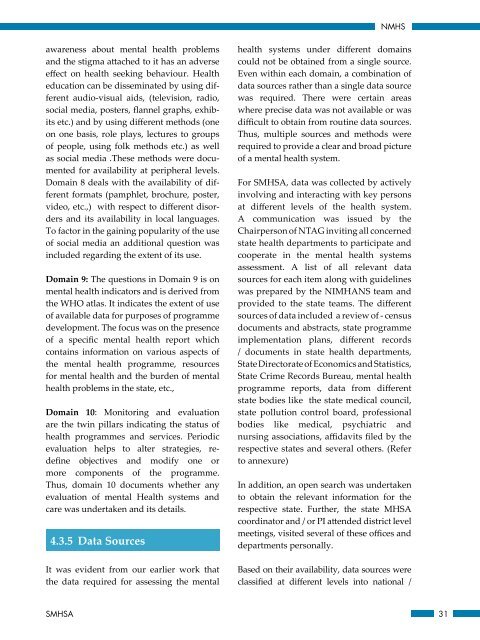National Mental Health Survey of India 2015-16
NMHS%20Report%20%28Mental%20Health%20Systems%29%201
NMHS%20Report%20%28Mental%20Health%20Systems%29%201
You also want an ePaper? Increase the reach of your titles
YUMPU automatically turns print PDFs into web optimized ePapers that Google loves.
NMHS<br />
awareness about mental health problems<br />
and the stigma attached to it has an adverse<br />
effect on health seeking behaviour. <strong>Health</strong><br />
education can be disseminated by using different<br />
audio-visual aids, (television, radio,<br />
social media, posters, flannel graphs, exhibits<br />
etc.) and by using different methods (one<br />
on one basis, role plays, lectures to groups<br />
<strong>of</strong> people, using folk methods etc.) as well<br />
as social media .These methods were documented<br />
for availability at peripheral levels.<br />
Domain 8 deals with the availability <strong>of</strong> different<br />
formats (pamphlet, brochure, poster,<br />
video, etc.,) with respect to different disorders<br />
and its availability in local languages.<br />
To factor in the gaining popularity <strong>of</strong> the use<br />
<strong>of</strong> social media an additional question was<br />
included regarding the extent <strong>of</strong> its use.<br />
Domain 9: The questions in Domain 9 is on<br />
mental health indicators and is derived from<br />
the WHO atlas. It indicates the extent <strong>of</strong> use<br />
<strong>of</strong> available data for purposes <strong>of</strong> programme<br />
development. The focus was on the presence<br />
<strong>of</strong> a specific mental health report which<br />
contains information on various aspects <strong>of</strong><br />
the mental health programme, resources<br />
for mental health and the burden <strong>of</strong> mental<br />
health problems in the state, etc.,<br />
Domain 10: Monitoring and evaluation<br />
are the twin pillars indicating the status <strong>of</strong><br />
health programmes and services. Periodic<br />
evaluation helps to alter strategies, redefine<br />
objectives and modify one or<br />
more components <strong>of</strong> the programme.<br />
Thus, domain 10 documents whether any<br />
evaluation <strong>of</strong> mental <strong>Health</strong> systems and<br />
care was undertaken and its details.<br />
4.3.5 Data Sources<br />
It was evident from our earlier work that<br />
the data required for assessing the mental<br />
health systems under different domains<br />
could not be obtained from a single source.<br />
Even within each domain, a combination <strong>of</strong><br />
data sources rather than a single data source<br />
was required. There were certain areas<br />
where precise data was not available or was<br />
difficult to obtain from routine data sources.<br />
Thus, multiple sources and methods were<br />
required to provide a clear and broad picture<br />
<strong>of</strong> a mental health system.<br />
For SMHSA, data was collected by actively<br />
involving and interacting with key persons<br />
at different levels <strong>of</strong> the health system.<br />
A communication was issued by the<br />
Chairperson <strong>of</strong> NTAG inviting all concerned<br />
state health departments to participate and<br />
cooperate in the mental health systems<br />
assessment. A list <strong>of</strong> all relevant data<br />
sources for each item along with guidelines<br />
was prepared by the NIMHANS team and<br />
provided to the state teams. The different<br />
sources <strong>of</strong> data included a review <strong>of</strong> - census<br />
documents and abstracts, state programme<br />
implementation plans, different records<br />
/ documents in state health departments,<br />
State Directorate <strong>of</strong> Economics and Statistics,<br />
State Crime Records Bureau, mental health<br />
programme reports, data from different<br />
state bodies like the state medical council,<br />
state pollution control board, pr<strong>of</strong>essional<br />
bodies like medical, psychiatric and<br />
nursing associations, affidavits filed by the<br />
respective states and several others. (Refer<br />
to annexure)<br />
In addition, an open search was undertaken<br />
to obtain the relevant information for the<br />
respective state. Further, the state MHSA<br />
coordinator and / or PI attended district level<br />
meetings, visited several <strong>of</strong> these <strong>of</strong>fices and<br />
departments personally.<br />
Based on their availability, data sources were<br />
classified at different levels into national /<br />
SMHSA<br />
31


